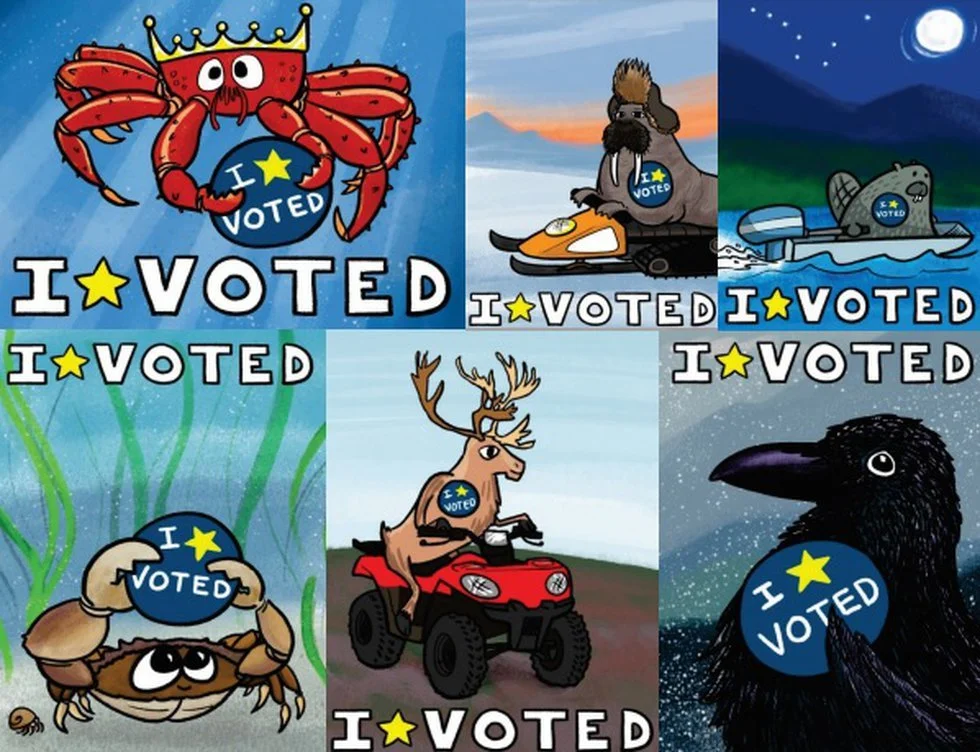Artwork by Barbara Lavallee
WE ASKED CANDIDATES THE
FOLLOWING EIGHT QUESTIONS:
CLICK THE BOX ABOVE TO EXPLORE THEIR RESPONSES:
Tabs at the bottom of this page separate the various seats
(ex. Governor, House Districts 31-40, etc)Candidates are listed in alphabetical order, by district number/letter
Party affiliations are not listed but can be found here
The following questions are aimed to address candidate positions on food policy in the State of Alaska. This questionnaire was submitted to all candidates, and here are their responses, which we are sharing in order to inform voters in the upcoming election.
Need assistance locating your district or registering to vote?
Check out the links at the end of this post.
Food systems encompass the entire range of actors and their interlinked value-adding activities involved in the production, subsistence, aggregation, processing, distribution, consumption, and disposal of food products that originate from agriculture, forestry or fisheries, and parts of the broader economic, societal and natural environments in which they are embedded (Food and Agriculture Organization of the United Nations)
Everyone views food security through different lenses. The USDA defines “food security” as "access by all people at all times to enough food for an active, healthy life." What is a food security concern in your district and how have current global issues (ie. supply chain disruption, pandemic, climate change) shaped your thinking about food security in Alaska and how do you plan to address these issues if elected?
Alaska imports roughly 95% of purchased food resulting in about $2 billion leaving the local economy. On average, Alaskan communities have a 3-5 day supply of food on hand.
How can the State of Alaska encourage increasing the number of farms and expanding food production?Climate change, rising gas prices, transportation issues, increasing insurance costs, and rising prices of parts and ingredients, are all driving up the cost of food for Alaskans. Alaska’s dependence on imported food, numerous off-road communities, and reliance on subsistence foods, make for a complicated and vulnerable food system. What do you see as the best way the State of Alaska could support stabilizing the local food system?
Temperatures are rising in the Arctic, and around the state, at a rate 2.5 times as fast as the rest of the world. Climate change is affecting traditional foodways and displacing communities. Are there policies or programs that you would propose to address these issues and support continued access to traditional foods (ie. hunting, fishing, gathering)?
Alaska food production should be supported by federal and state agencies. For example, the Alaska Division of Agriculture and Alaska Seafood Marketing Institute are entities designed to support greater food production in the state. What state programs do you find valuable and how would you ensure the success of these critical programs? What could be improved?
Improving diets by eating more fruits and vegetables drastically lowers health care costs and produces better outcomes in almost every aspect of life. Many Alaskans struggle with food insecurity, including nearly 16% of kids. Demand for food assistance during the pandemic rose, and much of this continues, as inflation and other issues arise. What would you do to ensure that every Alaskan has access to reliable, sustainable, safe, healthy, culturally appropriate, and affordable food?
Alaska has no central food storage facilities due to the remote and distributed nature of Alaska’s communities. Here are a few examples of vital investments that would support greater food security and independence. How do you think the state could support and develop food systems infrastructures, such as processing and cold storage?
Land is an essential part of growing more food. Access to viable and affordable farmland can inhibit establishing new farms, whether it's developing raw land or keeping established farmland in production. What do you think are the best ways for responsibly and sustainably developing and maintaining land for food production?
Artwork by Pat Race
ALASKA DIVISION OF ELECTIONS
For information on:
VOTER REGISTRATION
REQUESTING A VOTE BY MAIL BALLOT, and
POLLING LOCATIONS and more!
FIND YOUR LEGISLATORS
The Alaska Food Policy Council is a 501(c)(3) non-profit organization. We do not endorse specific candidates or political parties. Every candidate was provided with the opportunity to complete this survey so that we may share their views on various Alaska food system issues. Please check back regularly if you don’t see a candidate’s response- we will add more responses as they are sent in.







